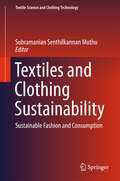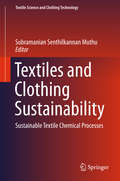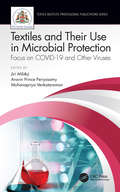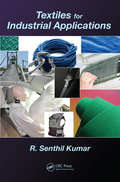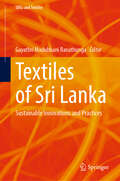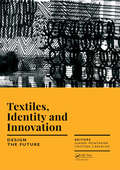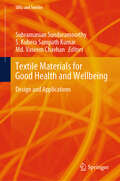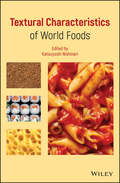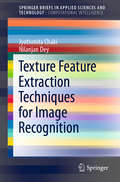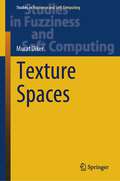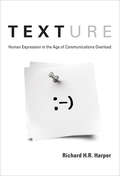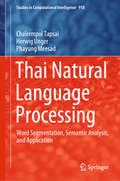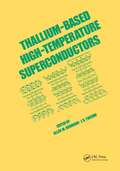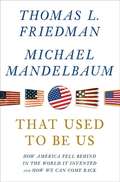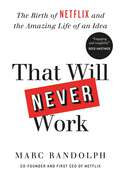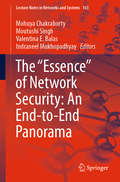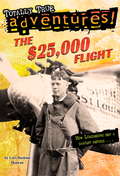- Table View
- List View
Textiles and Clothing Sustainability: Sustainable Fashion and Consumption
by Subramanian Senthilkannan MuthuThis is the first book to introduce and explain the concept of sustainable consumption with reference to the clothing sector. It uses various case studies to detail sustainable consumption behavior in the industry. Consumption is a key issue and is a major driver when it comes to sustainability in any industry, including clothing sector. Several studies which have highlighted the need for sustainable consumption in the clothing sector are discussed in this book.
Textiles and Clothing Sustainability: Sustainable Textile Chemical Processes
by Subramanian Senthilkannan MuthuThis book highlights the challenges in sustainable wet processing of textiles, natural dyes, enzymatic textiles and sustainable textile finishes. Textile industry is known for its chemical processing issues and many NGO’s are behind the textile sector to streamline its chemical processing, which is the black face of clothing and fashion sector. Sustainable textile chemical processes are crucial for attaining sustainability in the clothing sector. Seven comprehensive chapters are aimed to highlight these issues in the book.
Textiles and Human Thermophysiological Comfort in the Indoor Environment
by Radostina A. AngelovaTextiles and Human Thermophysiological Comfort in the Indoor Environment delivers a methodical assessment of textile structures for various applications in the indoor environment with respect to the thermophysiological comfort of the inhabitants. The book begins by offering an overview of the role of indoor textiles and clothing as a barrier betwee
Textiles and Their Use in Microbial Protection: Focus on COVID-19 and Other Viruses (Textile Institute Professional Publications)
by Aravin Prince Periyasamy Mohanapriya Venkataraman Jiri MilitkýTextiles and Their Use in Microbial Protection: Focus on COVID-19 and Other Viruses provides readers with vital information about disinfection mechanisms used in textile applications in the fight against dangerous microbes and viruses. KEY FEATURES: Introduces the basics of textile materials used for medical applications Features key information on virology, characterization, indication, and passivation of COVID-19 Describes UV, photocatalysis, photooxidation, application of TiO2, copper-based viral inhibition, and activated carbon Discusses antiviral finishes for the protection against SARS-CoV-2, particle penetration in dense cotton fabrics under swollen state, and the impact of moisture on face masks and their designs Aimed at textile and materials engineers as well as readers in medical fields, this text offers a comprehensive view of fundamentals and solutions in the use of textiles for microbial protection.
Textiles for Industrial Applications
by R. Senthil KumarAn evolution is currently underway in the textile industry and Textile for Industrial Applications is the guidebook for its growth. This industry can be classified into three categories-clothing, home textile, and industrial textile. Industrial textiles, also known as technical textiles, are a part of the industry that is thriving and showing great
Textiles of Sri Lanka: Sustainable Innovations and Practices (SDGs and Textiles)
by Gayathri Madubhani RanathungaThis book highlights the role of sustainable development in ancient practices to modern innovations in the textiles of Sri Lanka. It reveals the textile of Sri Lanka from the historical age to current tech-fabrics. Supporting the sustainable development goals, this book covers the most sought-after concepts and practices in textile industry of Sri Lanka such as of maximum utilization, zero waste, eco-friendly production process, reuse, upcycling, recycling, and longevity. Various topics covered in this book are indigenous cultural textiles, women empowerment, agro-waste utilization, secondhand-fashion consumption, and many more. The book is a valuable reference for beginners, university students, researchers, and professionals interested in sustainable development in textiles and allied fields.
Textiles, Identity and Innovation: Proceedings of the 1st International Textile Design Conference (D_TEX 2017), November 2-4, 2017, Lisbon, Portugal
by Gianni Montagna; Cristina CarvalhoD_TEX presents itself as a starting point at a crossroads of ideas and debates around the complex universe of Textile Design in all its forms, manifestations and dimensions. The textile universe, allied to mankind since its beginnings, is increasingly far from being an area of exhausted possibilities, each moment proposing important innovations that need a presentation, discussion and maturation space that is comprehensive and above all inter- and transdisciplinary. Presently, the disciplinary areas where the textile area is present are increasing and important, such as fashion, home textiles, technical clothing and accessories, but also construction and health, among others, and can provide new possibilities and different disciplinary areas and allowing the production of new knowledge. D_TEX proposes to join the thinking of design, with technologies, tradition, techniques, and related areas, in a single space where ideas are combined with the technique and with the projectual and research capacity, thus providing for the creation of concepts, opinions, associations of ideas, links and connections that allow the conception of ideas, products and services. The interdisciplinary nature of design is a reality that fully reaches the textile material in its essence and its practical application, through the synergy and contamination by the different interventions that make up the multidisciplinary teams of research. The generic theme of D_TEX Textile Design Conference 2017, held at Lisbon School of Architecture of the University of Lisbon, Portugal on November 2-4, 2017, is Design the Future, starting from the crossroads of ideas and debates, a new starting point for the exploration of textile materials, their identities and innovations in all their dimensions.
Textile Materials for Good Health and Wellbeing: Design and Applications (SDGs and Textiles)
by Subramanian Sundaramoorthy S. Kubera Sampath Kumar Md. Vaseem ChavhanThis book explores the application of latest technologies such as nanotechnology, composite technology, biotechnology in textile materials for health-related applications. It further discusses different types of textiles and their application in the areas of health, safety and well-being. Various topics covered in this book are, medical textiles, filtration textiles, protective textiles, thermal protective wear, intelligent textiles and many more. The book also deals with air and water filtration textiles and textile-based personal protective equipments. This book will be of interest for students, researchers and professionals working in the area of textile engineering, materials, biomedical engineering, defense, healthcare and other allied fields.
Textual Intercourse
by Laura SabaForget instant messaging and e-mail?we are undergoing a text message revolution Text messaging is the newest and preferred wave of communication for the younger demographic and the number one application of cell phones. The market is ripe for this relationship guide for texters With this new trend come all kinds of questions and confusion concerning textual communication and protocol within relationships girls never would have imagined a generation ago. Tantalizing topics include: ? The dos and donOCOts of texting your significant other? Interpreting exactly what his text messages mean? Finding the right balance between texting and in-person communication? The ins and outs of building textual confidence? The art of textual flirtation? And so much more This revealing and useful book demonstrates exactly how those tiny text messages you send today can create big success for your love life tomorrow. "
Textual Poachers: Television Fans and Participatory Culture
by Henry JenkinsThe culture of fanfiction.
Textural Characteristics of World Foods
by Katsuyoshi NishinariA complete guide to the textural characteristics of an international array of traditional and special foods It is widely recognized that texture has an intrinsic relationship to food preference. A full understanding of its functions and qualities is, therefore, of crucial importance to food technologists and product developers, as well as those working towards the treatment of dysphagia. Textural Characteristics of World Foods is the first book to apply a detailed set of criteria and characteristics to the textures of traditional and popular foods from across the globe. Structuring chapters by region, its authors chart a journey through the textural landscapes of each continent’s cuisines, exploring the complex and symbiotic relationships that exist between texture, aroma, and taste. This innovative text: Provides an overview of the textural characteristics of a wide range of foods Includes descriptions of textures and key points of flavor release Examines the relationships between the texture, taste, and aroma of each food presented Is structured by geographic region Rich with essential insights and important research, Textural Characteristics of World Foods offers all those working in food science and development a better picture of texture and the multifaceted role it can play.
Texture Feature Extraction Techniques for Image Recognition (SpringerBriefs in Applied Sciences and Technology)
by Nilanjan Dey Jyotismita ChakiThe book describes various texture feature extraction approaches and texture analysis applications. It introduces and discusses the importance of texture features, and describes various types of texture features like statistical, structural, signal-processed and model-based. It also covers applications related to texture features, such as facial imaging. It is a valuable resource for machine vision researchers and practitioners in different application areas.
Texture Spaces (Studies in Fuzziness and Soft Computing #411)
by Murat DikerThis book provides a complete framework for the fundamental concepts and results of texture spaces and its applications. The principal aim is to present a comprehensive arguments due to connections among the textures, fuzzy sets and rough sets. In this context, direlations, fuzzy direlations and fuzzy relations constitute a bridge for the remarkable observations on rough set theory. In a more general setting, the approximation operators are also inspected for fuzzy rough set models with two domains of discourse. Since the book is self-contained and reader-friendly, the respected researchers may utilize this source for further investigations of the necessary results for their studies on rough set theory using textures. Therefore, prospective readers are not only mathematicians who interest in purely mathematical theories related to textures, but also engineers of information sciences who need more information for their interdisciplinary studies with respect to rough sets and fuzzy sets.
Texture: Human Expression in the Age of Communications Overload (The\mit Press Ser.)
by Richard H. HarperWhy we complain about communication overload even as we seek new ways to communicate.Our workdays are so filled with emails, instant messaging, and RSS feeds that we complain that there's not enough time to get our actual work done. At home, we are besieged by telephone calls on landlines and cell phones, the beeps that signal text messages, and work emails on our BlackBerrys. It's too much, we cry (or type) as we update our Facebook pages, compose a blog post, or check to see what Shaquille O'Neal has to say on Twitter. In Texture, Richard Harper asks why we seek out new ways of communicating even as we complain about communication overload.Harper describes the mistaken assumptions of developers that “more” is always better and argues that users prefer simpler technologies that allow them to create social bonds. Communication is not just the exchange of information. There is a texture to our communicative practices, manifest in the different means we choose to communicate (quick or slow, permanent or ephemeral).
Texturising: Defects, Causes, Effects, Remedies and Prevention through Quality Management
by H. V. Sreenivasamurthy B. PurushothamaDrawing on the expertise of both academic and industry professionals, this book details all the fundamental aspects of yarn texturizing technology. From the origins of texturizing to machinery types, process control, quality testing, and management systems, the topics covered in this book serves as a guide to understanding and improving industry practices. Focusing on common challenges and solutions, this book is aimed at students studying man-made fibers and textiles, as well as shop-floor personnel navigating the day-to-day issues of texturizing units in India. The subject matter of this book also discusses: Types and Advantages of Texturised Yarns Work and Total Quality Management Training and Education of People on Work Wickability Tests Evaluation of Physical Bulk of Air-Texturised Yarns Print edition not for sale in South Asia (India, Sri Lanka, Nepal, Bangladesh, Pakistan or Bhutan)
Thai Natural Language Processing: Word Segmentation, Semantic Analysis, and Application (Studies in Computational Intelligence #918)
by Phayung Meesad Herwig Unger Chalermpol TapsaiThis book presents comprehensive solutions for readers wanting to develop their own Natural Language Processing projects for the Thai language. Starting from the fundamental principles of Thai, it discusses each step in Natural Language Processing, and the real-world applications. In addition to theory, it also includes practical workshops for readers new to the field who want to start programming in Natural Language Processing. Moreover, it features a number of new techniques to provide readers with ideas for developing their own projects. The book details Thai words using phonetic annotation and also includes English definitions to help readers understand the content.
Thallium-Based High-Tempature Superconductors
by Alien M. HermannProvides information on all chemical, physical and material aspects of this class of cuprates, and covers their applications. This work provides data on the chemistry, solid-state chemistry, handling and safety requirements of thallium.
Thank a Farmer
by Maria GianferrariInfused with jubilance and warmth, this luminous, lyrical picture book celebrates the people and the work that put food on our tables. Bread, milk, wool, fruits, and vegetables: things that fill our day to day lives. But where, and who, do they come from? Across wheat fields and city rooftop gardens, mushroom beds and maple forests, Thank a Farmer traces the food and clothing that a family uses back to the people who harvested and created them. With Maria Gianferrari’s informed and poetic text and monumental artwork from Monica Mikai, Thank a Farmer gently emphasizes the importance of agriculture in our day-to-day lives and reminds readers to give thanks to farmworkers around the world.
That Crazy Eddie and the Science Project of Doom
by Judy CoxBest friends Matt and Eddie have a falling out that threatens to ruin their science fair project. Includes instructions for making a model of an erupting volcano.
That Used to Be Us: How America Fell Behind in the World It Invented and How We Can Come Back
by Thomas L. Friedman Michael MandelbaumAmerica is in trouble. We face four major challenges on which our future depends, and we are failing to meet them -- and if we delay any longer, soon it will be too late for us to pass along the American dream to future generations. In That Used to Be Us, Thomas L. Friedman, one of our most influential columnists, and Michael Mandelbaum, one of our leading foreign policy thinkers, offer both a wake-up call and a call to collective action. They analyze the four challenges we face -- globalization, the revolution in information technology, the nation's chronic deficits, and our pattern of excessive energy consumption -- and spell out what we need to do now to sustain the American dream and preserve American power in the world. They explain how the end of the Cold War blinded the nation to the need to address these issues seriously, and how China's educational successes, industrial might, and technological prowess remind us of the ways in which "that used to be us. " They explain how the paralysis of our political system and the erosion of key American values have made it impossible for us to carry out the policies the country urgently needs. And yet Friedman and Mandelbaum believe that the recovery of American greatness is within reach. They show how America's history, when properly understood, offers a five-part formula for prosperity that will enable us to cope successfully with the challenges we face. They offer vivid profiles of individuals who have not lost sight of the American habits of bold thought and dramatic action. They propose a clear way out of the trap into which the country has fallen, a way that includes the rediscovery of some of our most vital traditions and the creation of a new thirdparty movement to galvanize the country. That Used to Be Us is both a searching exploration of the American condition today and a rousing manifesto for American renewal.
That Will Never Work: The Birth of Netflix by the first CEO and co-founder Marc Randolph
by Marc RandolphIn the tradition of Phil Knight's Shoe Dog comes the incredible untold story of how Netflix went from concept to company - all revealed by co-founder and first CEO Marc Randolph.Once upon a time, brick-and-mortar video stores were king. Late fees were ubiquitous, video-streaming unheard of, and widespread DVD adoption seemed about as imminent as flying cars. These were the widely accepted laws of the land in 1997 when Marc Randolph had an idea. It was a simple thought - leveraging the internet to rent movies - and was just one of many more proposals, like personalised baseball bats and a shampoo delivery service, that Randolph would pitch to his business partner, Reed Hastings, on their commute to work each morning. But Hastings was intrigued, and the pair - with Hastings as the primary investor and Randolph as the CEO - founded a company. Now with over 150 million subscribers, Netflix's triumph feels inevitable but the twenty-first century's most disruptive start-up began with few believers and calamity at every turn. From having to pitch his own mother on being an early investor, to the motel conference room that served as a first office, to server crashes on launch day, to the now-infamous meeting when they pitched Blockbuster to acquire them, Marc Randolph's transformational journey exemplifies how anyone with grit, gut instincts and determination can change the world - even with an idea that many think will never work. What emerges, however, isn't just the inside story of one of the world's most iconic companies. Full of counter-intuitive concepts and written in binge-worthy prose, it answers some of our most fundamental questions about taking that leap of faith in business or in life: How do you begin? How do you weather disappointment and failure? How do you deal with success? What even is success? From idea generation to team building to knowing when it's time to let go, That Will Never Work is not only the ultimate follow-your-dreams parable but also one of the most dramatic and insightful entrepreneurial stories of our time. (p) 2019 Octopus Publishing Group
That Will Never Work: The Birth of Netflix by the first CEO and co-founder Marc Randolph
by Marc RandolphIn the tradition of Phil Knight's Shoe Dog comes the incredible untold story of how Netflix went from concept to company - all revealed by co-founder and first CEO Marc Randolph."Engaging and insightful." --Reed Hastings, CEO of Netflix "As the founding CEO, Marc Randolph's leadership defined the culture of Netflix and laid the groundwork for successive, global revolutions in how we make and consume entertainment." --Gina Keating, author of Netflixed: The Epic Battle for America's Eyeballs "Charming, fascinating and very funny. If you've ever wondered how to turn an idea into a global household name, Marc Randolph will demystify the world of Silicon Valley start-ups, and make you laugh a lot along the way." --Decca Aitkenhead, The Sunday Times "A charming first-person account of the early days of one of the most successful tech start-ups ever. An engaging read that will engross any would-be entrepreneur." --The Washington PostOnce upon a time, brick-and-mortar video stores were king. Late fees were ubiquitous, video-streaming unheard of, and widespread DVD adoption seemed about as imminent as flying cars. These were the widely accepted laws of the land in 1997 when Marc Randolph had an idea. It was a simple thought - leveraging the internet to rent movies - and was just one of many more proposals, like personalised baseball bats and a shampoo delivery service, that Randolph would pitch to his business partner, Reed Hastings, on their commute to work each morning. But Hastings was intrigued, and the pair - with Hastings as the primary investor and Randolph as the CEO - founded a company. Now with over 150 million subscribers, Netflix's triumph feels inevitable but the twenty-first century's most disruptive start-up began with few believers and calamity at every turn. From having to pitch his own mother on being an early investor, to the motel conference room that served as a first office, to server crashes on launch day, to the now-infamous meeting when they pitched Blockbuster to acquire them, Marc Randolph's transformational journey exemplifies how anyone with grit, gut instincts and determination can change the world - even with an idea that many think will never work. What emerges, however, isn't just the inside story of one of the world's most iconic companies. Full of counter-intuitive concepts and written in binge-worthy prose, it answers our most fundamental questions about taking that leap of faith in business or in life: How do you begin? How do you weather disappointment and failure? How do you deal with success? What even is success? From idea generation to team building to knowing when it's time to let go, That Will Never Work is not only the ultimate follow-your-dreams parable but also one of the most dramatic and insightful entrepreneurial stories of our time. "Marc wastes no time cutting through the noise. He understands what is important whether it is your product, your marketing, or your business plan. A remarkable and one of a kind visionary." --Mitch Lowe, founder of RedBox and CEO of MoviePass "An entertaining chronicle of creativity, luck, and unflagging perseverance." --Kirkus
The Mechanics and Reliability of Films, Multilayers and Coatings
by Matthew R. Begley John W. HutchinsonA wide variety of applications ranging from microelectronics to turbines for propulsion and power generation rely on films, coatings, and multilayers to improve performance. As such, the ability to predict coating failure - such as delamination (debonding), mud-cracking, blistering, crack kinking, and the like - is critical to component design and development. This work compiles and organizes decades of research that established the theoretical foundation for predicting such failure mechanisms, and clearly outlines the methodology needed to predict performance. Detailed coverage of cracking in multilayers is provided, with an emphasis on the role of differences in thermoelastic properties between the layers. The comprehensive theoretical foundation of the book is complemented by easy-to-use analysis codes designed to empower novices with the tools needed to simulate cracking; these codes enable not only precise quantitative reproduction of results presented graphically in the literature, but also the generation of new results for more complex multilayered systems.
The "Essence" of Network Security: An End-to-End Panorama (Lecture Notes in Networks and Systems #163)
by Valentina E. Balas Mohuya Chakraborty Moutushi Singh Indraneel MukhopadhyayThis edited book provides an optimal portrayal of the principles and applications related to network security. The book is thematically divided into five segments: Part A describes the introductory issues related to network security with some concepts of cutting-edge technologies; Part B builds from there and exposes the readers to the digital, cloud and IoT forensics; Part C presents readers with blockchain and cryptography techniques; Part D deals with the role of AI and machine learning in the context of network security. And lastly, Part E is written on different security networking methodologies. This is a great book on network security, which has lucid and well-planned chapters. All the latest security technologies are thoroughly explained with upcoming research issues. Details on Internet architecture, security needs, encryption, cryptography along with the usages of machine learning and artificial intelligence for network security are presented in a single cover. The broad-ranging text/reference comprehensively surveys network security concepts, methods, and practices and covers network security policies and goals in an integrated manner. It is an essential security resource for practitioners in networks and professionals who develop and maintain secure computer networks.
The $25,000 Flight
by Wesley Lowe Lori Haskins HouranThe most exciting adventures are the ones that really happened! This brand-new Totally True Adventures book follow America's first superstar pilot, Charles Lindbergh. In the 1920s, flying was brand new--and very dangerous. A $25,000 prize for the first flight from New York to Paris went unclaimed for years. Many teams tried. And many teams failed. Still, Charles Lindbergh felt he had a shot at the prize. He wasn't famous. He wasn't rich. But he was determined. He'd cross the ocean in a tiny plane . . . and he'd do it all by himself! After you've read the story, don't miss the bonus content with extra facts, a timeline, and more 20th century history, geography, and science-tie-ins!From the Trade Paperback edition.
